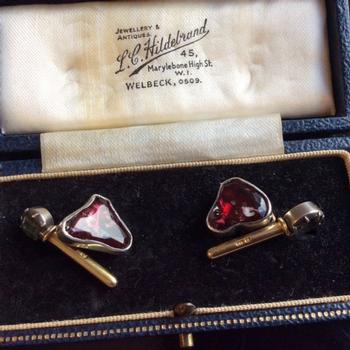Cufflinks a gentlemans jewel and pratical
Posted by Iain Brunt on 18/04/2017
Although the first cufflinks appeared in the 1600s, they did not become common until the end of the 18th century
Although the first cufflinks appeared in the 1600s, they did not become common until the end of the 18th century. Their development is closely related to that of the men's shirt. Men have been wearing shirt-like items of clothing since the invention of woven fabric 5,000 years BC. Although styles and methods of manufacturing changed, the underlying form remained the same: a tunic opened to the front with sleeves and collar. The shirt was worn directly next to the skin, it was washable and thereby protected the outer garments from contact with the body. Conversely, it also protected the skin against the rougher and heavier fabrics of jackets and coats by covering the neck and wrists.
After the Middle Ages the visible areas of the shirt (neck, chest and wrists) became sites of decorative elements such as frills, ruffs and embroidery. The cuffs were held together with ribbons, as were collars, an early precursor of neckties. Frills that hung down over the wrist were worn at court and other formal settings until the end of the 18th century, whilst in the everyday shirts of the time the sleeves ended with a simple ribbon or were secured with a button or a connected pair of buttons.
In the 19th century the former splendour of the aristocracy was superseded by the bourgeois efficiency of the new employed classes. From then onward men wore a highly conventional wardrobe: a dark suit by day, a dinner jacket or tailcoat in the evening. By the middle of the 19th century the modern cufflink became popular. The shirt front as well as collar and cuffs covering areas of the most wear were made sturdier. This was practical but when clean and starched, collars and cuffs underscored the formal character of the clothing. However, they could be too stiff to secure the cuffs with a simple button. As a consequence, from the mid 19th century onward men in the middle and upper classes wore cufflinks. The industrial revolution meant that these could be mass-produced, making them available in every price category.
Coloured cufflinks made from gemstones were initially only worn by men with a great deal of self-confidence, however. This situation changed when the Prince of Wales, later Edward VII, popularised colourful Fabergé cufflinks by the 19th century. During this time cufflinks became fashion accessories and one of the few acceptable items of jewellery for men in Britain and the U.S.
This development continued into the early 1900s, with more cufflinks worn than ever before. These were available in every type of form, colour and material, incorporating both gemstones and less precious stones and glass in cheaper copies. Intricate coloured enamelled cufflinks in every conceivable geometric pattern were especially popular. All of these were of equal value, as Coco Chanel had made fashion jewellery acceptable to wear. In a parallel development, however, a sportier style of shirt emerged with unstarched cuffs that could be secured with simple buttons.
This spread to Europe as well over the same period. In Germany, Idar-Oberstein and Pforzheim were key centres of cufflink production. Whilst in Idar-Oberstein cufflinks were produced using simple materials for the more modest budget, the Pforzheim jewellery manufacturers produced for the medium and upper segments using genuine gold and silver. In Pforzheim premium cufflinks are still produced today, some of them to historic patterns, some modern, all of them using traditional craftsmanship.
Following the end of shortages related to the Second World War, into the 1950s a gentleman liked to adorn himself with a whole range of accessories, comprising items such as cigarette case, lighter, tie pin or tie bar, watch (now worn mostly on the wrist instead of the pocket), ring, key chain, money clip, etc., an ensemble that also included a wide range of cufflinks.





